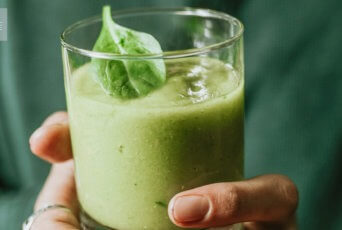We’re not going to fudge the truth (see what we did there?): sugar is delicious. There’s a reason desserts are called “treats,” after all. But consuming too much sugar has a ton of serious health repercussions — from inflammation to chronic disease to cancer — and the reality is that most Americans have too much sugar in their diet. Because of this, the idea of a “sugar detox” has gained popularity, but can following a sugar detox plan really improve your health? Read on to learn the benefits of cutting out sugar and how to detox from sugar safely.
Listen to this guide on The WellBe Podcast.
The Benefits of Cutting Out Sugar
Americans eat a lot of sugar. In the United States, added sugars account for about 17% of most adults’ diets, with the average U.S. adult consuming 22 teaspoons of sugar per day — way above the recommended five teaspoons for women and nine for men. This matters because consuming excess sugar is linked to a ton of health issues. When you lay them all out, it can be pretty shocking to see just how damaging something so innocent-looking (and yummy) can be, but it’s important knowledge to have.
Consuming too much sugar has been linked to:
Heart disease. Studies show that eating a diet high in added sugar is associated with an increased risk of heart disease and heart disease mortality, with just one or two additional daily servings of sugar increasing your risk for coronary heart disease by 10-20%. On the flip side, eating a diet low in added sugar (such as Paleo or a vegan, whole foods-based diet) have been shown to significantly reduce levels of triglycerides and LDL cholesterol, both of which are major risk factors for heart disease.
Diabetes. Researchers think that one of the ways that excess sugar contributes to heart disease is via insulin resistance — and insulin resistance, of course, can also lead to type 2 diabetes. Studies show that frequently consuming foods or drinks with added sugar harms your blood sugar management and increases the risk of developing diabetes. Cutting back on sugar drops the level of sugar in your blood and can combat insulin resistance.
Weight gain & obesity. Foods with added sugar also tend to be low in nutrients like protein and fiber, and thus less filling, which means that eating these foods often contributes to overeating, weight gain, and obesity. Not only that, but high added sugar intake means that any excess weight is likely visceral fat, which is the abdominal fat that sits around your internal organs and is strongly correlated with all sorts of health conditions and mortality. Cutting out sugar — and replacing those high-sugar products with foods that are high in protein and fiber — has been shown to promote weight loss.
Poor dental health. In both kids and adults, sugar intake is highly associated with an increased risk of cavities and gum disease. The WHO recommends that people of all ages limit their added sugar intake to no more than 5% of their daily calories, as studies show that tooth decay sets in above that level.
Poor gut health. Humans aren’t the only ones who love sugar — so do the “bad” bacteria in your gut microbiome. These bad bacteria love simple carbs, especially sugar, and so their populations surge when you eat too much of it, at the expense of the good microbes in your gut. Excess sugar intake is particularly associated with the overgrowth of candida, a type of yeast that can lead to a variety of different health problems.
Liver problems. While we normally associate poor liver health with drinking too much, it can also be caused by eating too much sugar. Studies show that high-sugar diets — especially those high in fructose — increase the risk of developing non-alcoholic fatty liver disease, a condition in which fat builds up in the liver and impedes liver function.
Depression. In one study, researchers found that men and women who consumed 17 teaspoons or more of sugar per day (that’s over 67 grams) were likelier to experience depression symptoms over a five-year period. Those who cut back to 10 teaspoons or less (40 grams), had much lower rates of depression symptoms. This makes sense knowing what we know about the gut-brain connection and how gut health impacts depression.
Sugar addiction. The notion of sugar addiction is pretty buzzy, but there is some science behind it. Research shows that our brains actually can become addicted to sugar, and one particular study found that the most common foods associated with addiction are those with a lot of added sugar or fats. In fact, one eye-opening study showed that when rats were exposed to both sugar and cocaine, an overwhelming majority of them (40 out of 43) opted to consume the sugar over the notoriously addictive drug.
That’s a lot of potential risks, and seeing them all laid out makes the benefits of cutting out sugar pretty clear: if you cut down on your sugar intake, you’ll naturally alleviate any of the negative health impacts outlined above. But it’s not just about minimizing your risk of health issues — there are a ton of health perks that come from reducing your sugar intake. Some of the big benefits of cutting out sugar are:
More energy. While high-sugar foods give you an initial rush of energy, that boost is soon followed by a crash as soon as your body has burned through all those easy-to-digest simple carbs. By replacing sugars with protein, healthy fats, and complex carbs, you’ll have lasting energy for hours after eating.
Glowing skin. When your blood sugar levels are too high, it impedes your skin’s ability to repair its collagen, which is what makes your skin look hydrated and plump, so when you cut sugar, you’ll help your skin look youthful and dewy. Low-sugar diets have also been shown to help clear up acne-prone skin.
Improved sleep. Blood sugar dips can lead to nighttime wakings, so when you cut back on sugar and replace it with foods that take longer to digest, you’ll sleep more soundly throughout the night.
Better focus. Excess sugar can contribute to brain fog, so slashing your sugar intake will help clear things up. Research has also shown that low-sugar diets are linked to improved clarity and focus.
What’s more, detoxing from sugar will help “reset” your habits and your palette, so you’re less likely to crave excess sugar in the future (similar to cutting back on caffeine). Of course, that’s easier said than done, so it’s important to understand how to detox from sugar in a manageable, health-promoting way.
What About Sugar Withdrawal?
Remember that whole thing about sugar being addictive? While that’s a major reason to curb your sugar habit, it also makes cutting back more difficult. Just as alcoholics or drug addicts experience withdrawal symptoms, so can people who have become addicted to sugar. Studies have found that sugar triggers the release of dopamine, the so-called pleasure hormone that’s also associated with addictive drugs and alcohol. What’s more, several animal studies show that when rats become accustomed to consuming lots of sugar and are then deprived of it, they show opiate withdrawal symptoms and a decrease in dopamine release. Humans, too, can become accustomed to the dopamine surge that accompanies high-sugar foods, and so any sort of sugar detox could come with some withdrawal symptoms.
Of course, everyone reacts differently to cutting out sugar. Some may experience no symptoms at all, while others will experience every symptom severely. It all depends on how much sugar you were consuming before, your own personal body composition, and what sugar detox plan you try.
Some symptoms of sugar withdrawal include:
- Headaches. This is a common symptom of sugar withdrawal, as a sudden change in blood sugar level can cause a headache.
- Fatigue. If your body is used to the quick energy hit of sugar (never mind the subsequent crash) you can feel sluggish when you cut that sugar out.
- Muscular aches. Initially, your muscles aren’t happy with the lack of sugar, and you may feel pain as a result.
- Nausea, bloating, or cramps. Digestive issues like this can arise because of the sudden drop in dopamine, which not only controls the pleasure centers of your brain but also controls things like nausea and movement in your small intestine.
- Cognitive issues. When your blood sugar level drops suddenly, it can lead to confusion or difficulty concentrating in the short-term.
- Mood changes. Because all that feel-good dopamine is suddenly gone, you might feel irritable, anxious, or even depressed when cutting out sugar.
- Cravings. Naturally, you’ll initially crave the high-sugar foods you cut out, but sugar withdrawal can also cause you to crave other carb-heavy foods, like bread, pasta, chips, etc.
But the most important thing to understand is that all of these symptoms are temporary — they should go away within a few days or weeks — and generally quite mild. If you’ve been consuming a lot of sugar, suddenly cutting it out will be a big adjustment for your body, so give it time to recalibrate. The effects of sugar withdrawal are short-term, while the negative effects of consuming too much sugar can seriously affect your long-term health.
There is one potential long-term risk of a sugar detox: like any restrictive diet, a sugar detox plan may lead to unhealthy behaviors or thoughts in some people. Those with a history of an eating disorder or disordered eating, or who already have a problematic relationship with food and their body, may want to be careful when attempting to reduce sugar intake. For these people, it’s probably best to work with a nutritionist and try a gradual approach focused on intuitive eating rather than strict rules.
How to Detox from Sugar: Best Practices
Now that we’ve laid out the benefits of cutting out sugar, let’s get into how to do it. We’ll share some specifics on sugar detox plans below, but for now we’ll talk about some general best practices for how to detox from sugar.
If you’re seriously considering doing a sugar detox, it’s wise to follow these guidelines:
- Choose your length. Sugar detoxes can vary widely in length — some are three days, some are a week, some are 30 days, some don’t even have an end date and are more of a lifestyle than a “challenge,” per se. Look at your calendar, think about your life, and decide what length of time you can commit to your sugar detox plan. (Just remember that if you go too short, you might not give your body enough time to fully detox. How long it takes for withdrawal symptoms to go away depends on various factors, and your sugar detox should definitely extend beyond when your symptoms dissipate so you can start reaping the benefits.)
- Choose your level of strictness. Some sugar detox plans are relatively loose, with an emphasis on cutting out added sugars and processed foods, while others are quite strict and don’t even allow fruit. Some people do a blend and only allow low-sugar fruits on their sugar detox like citrus fruits, berries, melons and avocados. Think about your goals and what would be feasible for your lifestyle to decide how strict you want to go.
- Decide whether you want to go cold turkey or ease in. On this front, there’s not really a consensus on how to detox from sugar. While the team at Parsley Health recommends slowly cutting out sugar and building up to a full sugar “cleanse,” other experts advise doing a few days of a very strict, zero sugar diet, then gradually adding back in foods like fruit, starchy vegetables, and grains.
- Focus on what you’re adding, not what you’re taking out. To help curb cravings and make your sugar detox sustainable, make sure you’re adding, not just subtracting. Replace high-sugar foods with filling, nutrient-dense foods that contain plenty of fiber and protein. This will help balance your blood sugar and curb cravings.
- Exercise. First off, the endorphin rush of exercise can serve as a substitute for the feel-good reward you get from sugar. Exercise has also been shown to help your body’s natural detoxification process, which is important because when you cut out sugar, your body’s natural detoxification organs (namely the liver and kidneys) are able to focus on getting rid of toxins rather than processing sugar. Exercise helps them along.
- Stay hydrated. Staying well hydrated is important all of the time, but it’s especially essential when your body is going through a period of detoxification. Water helps your system flush toxins out of your body by supporting vital organs in their functions.
- Track your symptoms and progress. Make a big “X” on your calendar for each day you complete of your sugar detox, and keep a journal where you document things like your sleep, mood, cravings, and energy levels. While you might see a dip at first because of sugar withdrawal symptoms, you’ll likely start seeing tons of progress afterward. This will be incredibly motivating!
- Make the commitment. Sure, there might be some physical challenges with cutting out sugar, but it’s really a mental game. Get your head in the right place by fully deciding that you’re all in on your sugar detox. Write it down, tell others for accountability, promise yourself some prize at the end — whatever you need to do to completely commit.
Lastly, make sure that you use your sugar detox as a way to reset your relationship with sugar, not a one-time challenge to prove a point. If you cut out sugar for 30 days and then immediately return to a diet that’s high in processed foods and added sugar, any of the benefits of cutting out sugar will be lost.
A Sugar Detox Plan Template
We’ve covered the basics on how to detox from sugar, so now it’s time for the specifics. While there are many different sugar detox plans, most adhere to the same fundamental principles on what you can and can’t eat.
What to avoid on a sugar detox plan:
- Sugar. This one is laughably obvious, but we’ve gotta put it in here. That means all forms of sugar — table sugar, brown sugar, honey, agave, coconut sugar, etc — are off the table (literally). And don’t be fooled! There are over 100 words for sugar and sugar alcohols on ingredient lists. Companies are now aware people are trying to avoid sugar so they use many other words and forms of sugar to hide the presence of sugar in their food products.
- Sweets. Another obvious one, but it’s gotta be on here! No cookies, candy, ice cream or any other sugar sweet treats.
- Sugary beverages. Soda, elaborate coffee drinks, and juice — yes, even all-natural, organic juice — are no-nos when you’re detoxing from sugar. Remember that a glass of orange juice will have way more sugar than an orange, so even if you choose to leave fruit in your diet during your sugar detox, definitely don’t have fruit juice.
- Artificial sweeteners. While this might seem like a clever shortcut to keep the sweetness without consuming sugar, artificial sweeteners have a ton of their own negative health effects. Plus, one of the big benefits of cutting out sugar is that it helps you reset your taste buds and stop craving extremely sweet foods, so if you’re still using artificial sugar to get that sweetness, you’re sort of missing the point.
- Processed foods. Even processed foods that you might not think of as “sweet” — like crackers, bread, even ketchup — probably contain lots of sugar. In fact, roughly 74% of packaged foods have added sugar! You can become an avid label reader, but it’s probably best to just skip processed foods altogether and focus on whole foods.
- Alcohol. Sorry, but you’ll likely need to skip out on happy hour (or order a sparkling water with lime!) while on your sugar detox plan. While some sugar detox plans might allow you to indulge in low-sugar drinks (check out our article on healthy alcohol to learn which drinks are lowest in sugar), it’s probably best to steer clear as a general rule.
Now for what you can eat! When you’re detoxing from sugar, your diet should include:
- Lots of protein. Think lean meats, legumes, eggs, and fish.
- Good fats. Avocado, extra virgin olive oil, nuts, and seeds are great sources of healthy fats.
- Whole grains and filling carbs. If you choose a super strict sugar detox plan, you might only be allowed to eat non-starchy vegetables (think “light” veggies, like green beans, asparagus, and spinach). However, many less rigid sugar detox plans allow for starchy vegetables (like squash and potatoes) and whole grains (quinoa, brown rice, farro, etc). These foods contain a lot of fiber, which is wonderful for both keeping you full and supporting healthy digestion.
- Fruit and vegetables. Fresh, organic produce is important for providing your body with vitamins and minerals. Again, some stricter plans won’t allow fruit, but many will. Choose low-sugar fruits like berries, melons, and citrus over high sugar fruits like mangoes and bananas, and pair fruit with some protein and fat to help stabilize your blood sugar. This could be a handful of almonds, some Greek yogurt, a drizzle of nut butter — whatever you like!
You can follow the guidelines above to come up with your own sugar detox plan, or you can search online for a specific, guided sugar detox plan to follow. There are countless articles, downloadable PDFs, books, and even apps to choose from.
The WellBe Takeaway on How to Detox from Sugar
Sugar is sweet and delicious, but too much can be bad for your health. All the wellness “experts” on social media and the marketing of “healthy” food products can make it even more confusing if you’re looking to reduce your sugar intake. Here’s what to remember about sugar and your health and how to detox from sugar:
- There are a ton of benefits of cutting out sugar. Sugar can contribute to many chronic health issues — like diabetes, heart disease, and liver problems — as well as obesity, tooth decay, and even depression. Cutting out sugar reduces your risk of these issues and alleviates any you already have.
- The benefits of cutting out sugar go beyond disease prevention: you’ll also experience more energy, glowing skin, better sleep, and improved mental clarity.
- When first cutting sugar, some people experience symptoms of sugar withdrawal. These symptoms can include fatigue, nausea, irritability, muscle aches, and cravings. These symptoms don’t affect everyone, and generally go away within a few days or weeks. Whether or not you experience them will depend on how much sugar you were eating before, how extreme your sugar detox plan is, and your unique body composition.
- When it comes to how to detox from sugar, there are several best practices. You must decide how long you want your detox to be (from a few days to over a month), how strict you want it to be, and whether to go cold turkey or take it slow. You should also focus on what you’re adding to your diet (namely, high-fiber, high-protein foods) rather than just what you’re cutting out), exercise regularly, stay hydrated, track your progress, and make a verbal or written commitment to your sugar detox plan.
- There are a ton of different specific sugar detox plans to choose from. Almost all of them will advise you to avoid sugary foods and beverages, processed foods, artificial sweeteners, and alcohol. Instead, you should eat lean proteins, healthy fats, fresh produce, and whole grains.
- You can choose whether to freestyle your sugar detox by following these best practices and diet principles, or find a specific meal plan. There are articles, downloadable guides, books, and even apps if you choose the latter.
Have you ever done a sugar detox? How did it go? Tell us about it in the comments below!
Listen to this guide on The WellBe Podcast.
Citations:
- Azaïs-Braesco V, Sluik D, Maillot M, Kok F, Moreno LA. A review of total & added sugar intakes and dietary sources in Europe. Nutr J. 2017 Jan 21;16(1):6.
- Huang C, Huang J, Tian Y, Yang X, Gu D. Sugar sweetened beverages consumption and risk of coronary heart disease: a meta-analysis of prospective studies. Atherosclerosis. 2014 May;234(1):11-6.
- Temple NJ. Fat, Sugar, Whole Grains and Heart Disease: 50 Years of Confusion. Nutrients. 2018 Jan 4;10(1):39.
- Pastore RL, Brooks JT, Carbone JW. Paleolithic nutrition improves plasma lipid concentrations of hypercholesterolemic adults to a greater extent than traditional heart-healthy dietary recommendations. Nutr Res. 2015 Jun;35(6):474-9.
- DiNicolantonio JJ, OKeefe JH. Added sugars drive coronary heart disease via insulin resistance and hyperinsulinaemia: a new paradigm. Open Heart. 2017 Nov 29;4(2):e000729.









COMMENTS